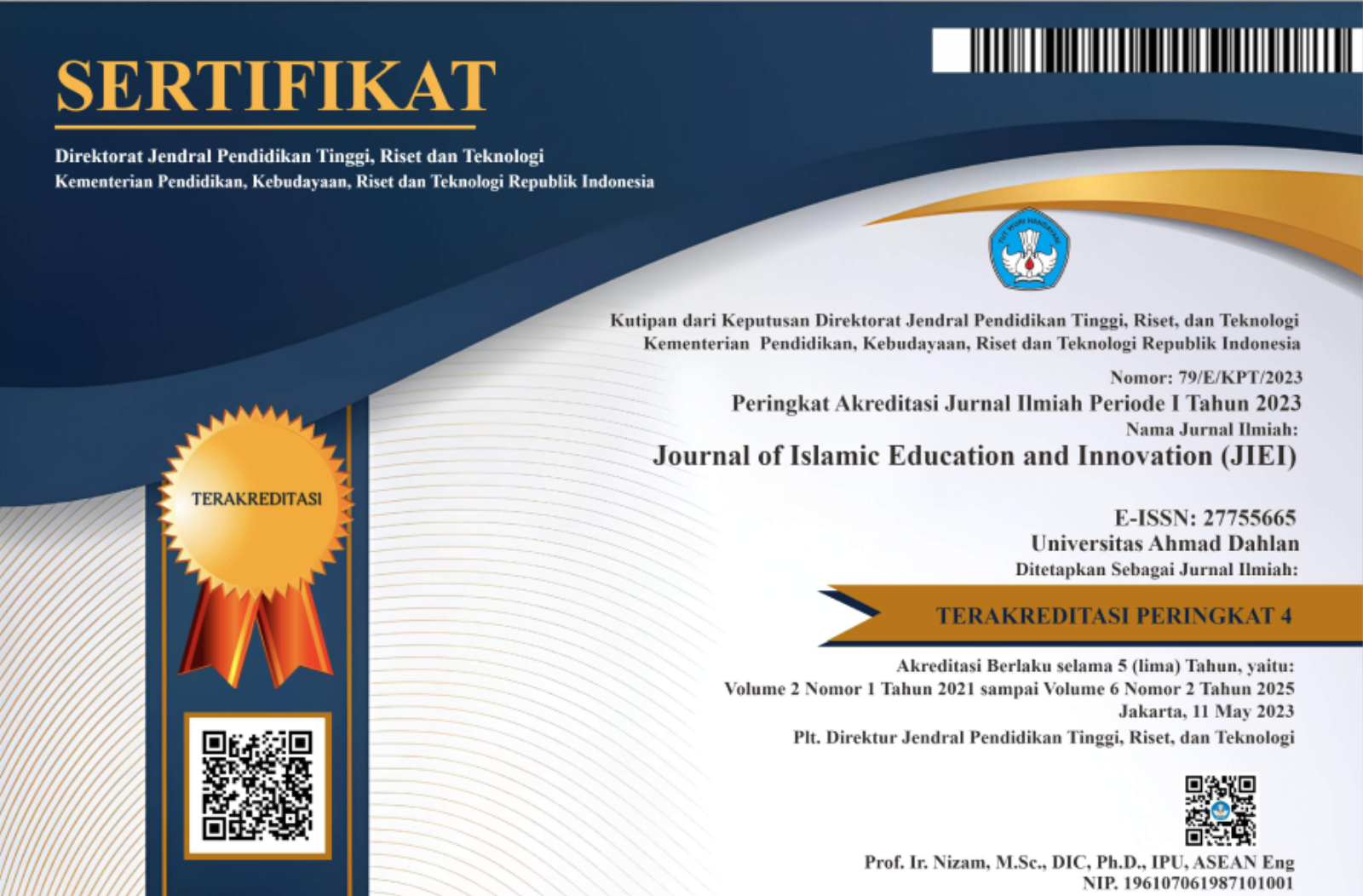Mengembangkan potensi beragama anak usia dini tinjauan teori Mature Religion
DOI:
https://doi.org/10.26555/jiei.v1i2.3412Keywords:
Potensi Beragama, Anak Usia Dini, Mature ReligionAbstract
Memberikan pengetahuan terutama pengetahuan keagamaan terhadap anak usia dini perlu ditanamkan di awal kehidupannya, karena mengingat urgensinya yang berkaitan dengan tumbuh kembang kejiwaan anak usia dini. Melalui kematangan agama akan menimbulkan dampak positif bagi prilaku anak usia dini. Tujuan penelitian ini mengembangakan potensi agama anak usia dini dan menemukan suatu metode pembelajaran yang tepat. Metode penelitian kualitatif, dengan pengumpukan data yang digunakan yaitu literature review. Hasil dari penelitian ini adalah perkembangan agama anak usia dini melalui kombinasi antara potensi bawaan atau fitrah dan potensi yang datang dari luar. Pendidikan merupakan sarana yang dapat mengubah rasa agama sebagai sesuatu yang bersifat potensi menjadi sesuatu yang bersifat aktual. Berdasarkan karakteristik rasa agama tersebut, metode yang cocok diantaranya adalah modeling, pembiasaan, bermain, bercerita, dan visiting.
References
Khadijah, “Pengembangan keagamaan anak usia dini,” Raudhah, vol. IV, no. 1, pp. 33–48, 2016.
W. Putra, “Perkembangan Anak Ditinjau dari Teori Mature Religion,” Nadwa, vol. 7, no. 1, p. 1, 2013, doi: 10.21580/nw.2013.7.1.541.
A. Yani, “Pendidikan Agama Pada Anak Oleh Orang Tua : Tinjauan Psikologi Islam,” J. Ilmu Agama UIN Raden Fatah, vol. 14, no. 1, pp. 33–44, 2013.
A. Souza, A. Kelleher, R. Cooper, R. A. Cooper, L. I. Iezzoni, and D. M. Collins, “Multiple sclerosis and mobility-related assistive technology: Systematic review of literature,” J. Rehabil. Res. Dev., vol. 47, no. 3, pp. 213–224, 2010, doi: 10.1682/JRRD.2009.07.0096.
W. Houston, “Sources :,” no. December 1994, pp. 1–5, 2021.
M. Q. Shihab, “Tafsir Maudhu’i atas Pelbagai Persoalan Umat Wawasan Al-Quran DAFTAR ISI BAB I Pokok-pokok Keimanan,” no. November, p. 571, 1996, [Online]. Available: www.bektiharjo.com.
R. Agama and U. Remaja, “Iin Inyani, Fungsi Conscience Dalam,......,” no. 2, pp. 187–202, 2015.
F. Syafri, “Memahami Perkembangan Psikologi Keagamaan Anak Usia Dini,” Al Fitrah J. Early Child. Islam. Educ., vol. 2, no. 1, p. 242, 2018, doi: 10.29300/alfitrah.v2i1.1519.
U. K. Rambe, “Pemikiran Amin Abdullah,” Al-Hikmah J. Theosof. dan Perad. Islam, vol. 1, no. 2, pp. 146–175, 2019.
A. About and O. Khyammam, “Chapter 7 :,” pp. 99–114.
P. Thagard, “The emotional coherence of religion,” J. Cogn. Cult., vol. 5, no. 1–2, pp. 58–74, 2005, doi: 10.1163/1568537054068642.
C. Smith, “Theorizing Religious Effects Among American Adolescents,” J. Sci. Study Relig., vol. 42, no. 1, pp. 17–30, 2003, doi: 10.1111/1468-5906.t01-1-00158.
Y. El-Menouar, “The Five Dimensions of Muslim Religiosity . Results of an Empirical Study,” Method, Data, Anal., vol. 8, no. 1, pp. 53–78, 2014, doi: 10.12758/mda.2014.003.
B. Haneman, “The Royal Society of Medicine,” Med. J. Aust., vol. 140, no. 3, pp. 179–179, 1984, doi: 10.5694/j.1326-5377.1984.tb103966.x.
G. V. Marr and R. Heppinstall, “on the autoionizatioOn transitions in thallium atoms,” Proc. Phys. Soc., vol. 87, no. 1, pp. 293–298, 1966, doi: 10.1088/0370-1328/87/1/333.
A. S. Lillard, “Playful learning and Montessori education,” Am. J. Play, vol. 5, no. 2, pp. 157–186, 2013, [Online]. Available: http://www.journalofplay.org/sites/www.journalofplay.org/files/pdf-articles/5-2-article-play-learning-and-montessori-education_0.pdf.
www.researchconnections.org, “Play and Learning In Early Care and Education Settings,” 2011.
R. Buku, T. Aulad, and A. N. Ulwan, “Artikel Pengajar Islam,” pp. 1–24, 2021.
G. Airenti, “[1] G. Airenti, ‘The development of anthropomorphism in interaction: Intersubjectivity, imagination, and theory of mind,’ Front. Psychol., vol. 9, no. NOV, pp. 1–13, 2018, doi: 10.3389/fpsyg.2018.02136.The development of anthropomorphism in interaction: I,” Front. Psychol., vol. 9, no. NOV, pp. 1–13, 2018, doi: 10.3389/fpsyg.2018.02136.
L. J. Bridges and K. a. Moore, “Religion and Spirituality in Childhood and Adolescence,” Child Trends, pp. 1–59, 2002, [Online]. Available: http://www.childtrends.org/wp-content/uploads/2002/01/Child_Trends-2002_01_01_FR_ReligionSpiritAdol.pdf.
M. Anak-anak, “Al-Ikhtibar: Jurnal Ilmu Pendidikan Volume 7 No. 2, Juli-Desember 2020,” vol. 7, no. 2, pp. 801–808, 2020.
Downloads
Published
Issue
Section
License
Copyright (c) 2020 Dwi Hastuti

This work is licensed under a Creative Commons Attribution-ShareAlike 4.0 International License.
License and Copyright Agreement
In submitting the manuscript to the journal, the authors certify that:
- They are authorized by their co-authors to enter into these arrangements.
- The work described has not been formally published before, except in the form of an abstract or as part of a published lecture, review, thesis, or overlay journal. Please also carefully read the International JIEI Author Guidelines at http://journal2.uad.ac.id/index.php/jiei/about/submissions#onlineSubmissions
- That it is not under consideration for publication elsewhere,
- That its publication has been approved by all the author(s) and by the responsible authorities “ tacitly or explicitly “ of the institutes where the work has been carried out.
- They secure the right to reproduce any material that has already been published or copyrighted elsewhere.
- They agree to the following license and copyright agreement.
Copyright
Authors who publish with the Journal of Islamic Education and Innovation agree to the following terms:
- Authors retain copyright and grant the journal right of first publication with the work simultaneously licensed under a Creative Commons Attribution License (CC BY-SA 4.0) that allows others to share the work with an acknowledgment of the work's authorship and initial publication in this journal.
- Authors are able to enter into separate, additional contractual arrangements for the non-exclusive distribution of the journal's published version of the work (e.g., post it to an institutional repository or publish it in a book), with an acknowledgment of its initial publication in this journal.
- Authors are permitted and encouraged to post their work online (e.g., in institutional repositories or on their website) prior to and during the submission process, as it can lead to productive exchanges, as well as earlier and greater citation of published work.









